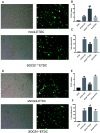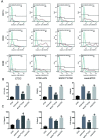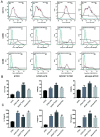Regulatory Effect of JAK2/STAT3 on the Immune Function of Endotoxin-tolerant Dendritic Cells and its Involvement in Acute Liver Failure
- PMID: 36304491
- PMCID: PMC9547265
- DOI: 10.14218/JCTH.2021.00175
Regulatory Effect of JAK2/STAT3 on the Immune Function of Endotoxin-tolerant Dendritic Cells and its Involvement in Acute Liver Failure
Abstract
Background and aims: Acute liver failure (ALF) is a potentially fatal clinical syndrome with no effective treatment. This study aimed to explore the role of Janus kinase 2/signal transducer and activator of transcription 3 (JAK2/STAT3) pathway in modulating the phenotype and immune function of endotoxin-tolerant dendritic cells (ETDCs). In addition, we explored the use of EDTCs in an experimental model of ALF and investigated the associated mechanisms.
Methods: In the in vitro experiment, ETDCs were transfected with adenovirus to induce SOCS1+/+ETDCs and SOCS1-/-ETDCs. Thereafter, costimulatory molecules and mixed lymphocyte reaction were assessed. Experimental mice were randomly divided into normal control, ALF, ALF+mock-ETDCs, ALF+SOCS1+/+ETDCs, ALF+AG490, and ALF+AG490+SOCS1+/+ETDCs groups. We examined the therapeutic effect of adoptive cellular immunotherapy by tail-vein injection of target ETDCs 12 h before ALF modeling. AG490, a JAK2/STAT3 inhibitor, was used in the in vivo experiment to further explore the protective mechanism of SOCS1+/+ETDCs.
Results: Compared with control ETDCs, SOCS1+/+ETDCs had lower expression of costimulatory molecules, weaker allostimulatory ability, lower levels of IL-6 and TNF-α expression and higher IL-10 secretion. SOCS1-/-ETDCs showed the opposite results. In the in vivo experiments, the ALF+SOCS1+/+ETDCs and ALF+AG490+SOCS1+/+ETDCs groups showed less pathological damage and suppressed activation of JAK2/STAT3 pathway. The changes were more pronounced in the ALF+AG490+SOCS1+/+ETDCs group. Infusion of SOCS1+/+ETDCs had a protective effect against ALF possibly via inhibition of JAK2 and STAT3 phosphorylation.
Conclusions: The SOCS1 gene had an important role in induction of endotoxin tolerance. SOCS1+/+ETDCs alleviated lipopolysaccharide/D-galactosamine-induced ALF by downregulating the JAK2/STAT3 signaling pathway.
Keywords: Acute; Dendritic cells; Endotoxin tolerance; Janus kinase 2/signal transducers and activators of transcription 3 (JAK2/STAT3); Liver failure.
© 2022 Authors.
Conflict of interest statement
ML has been an editorial board member of Journal of Clinical and Translational Hepatology since 2019. Other authors have no conflict of interests related to this publication.
Figures








References
LinkOut - more resources
Full Text Sources
Miscellaneous
